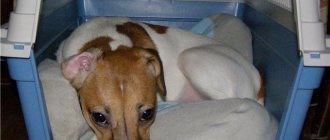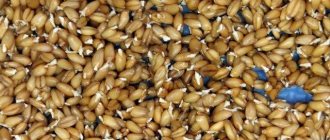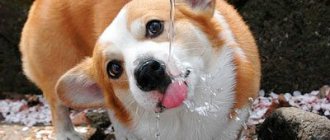Other reasons
In addition to the above, other factors can pose a danger to your pet, for example, water in its drinking bowl or potted plants!
It is important to remember to also keep in mind the temperature of the parrot.
Water
Always monitor the purity and quality of the water. If the parrot does not drink for more than two days, it will die from dehydration; the wavy has a fast metabolism, which means that any ailment can instantly develop into a big problem, which without surgical intervention will end in death.
Do not forget to check the serviceability of the drinker; cases when the hole through which water enters is blocked are far from uncommon.
Plants
We are not always aware that plants in our home can be poisonous, so before letting your bird go for a walk, it is worth removing all the pots. This will help protect the plants themselves from the parrot, who will not disdain to ruffle the leaves for his pleasure.
A cactus, for example, can leave its needles in an active parrot after close contact, causing the wounds to become inflamed and cause serious discomfort to the bird.
Diseases
We are talking about diseases that could have been avoided with due attention to safety. One of the common mistakes made by the owner of a parrot is to move a new tenant in with the old ones, without quarantine.
Even if a new parrot is taken from friends or from a trusted pet store, it must be kept in a separate cage for a month, where you can observe the behavior, appetite, droppings and activity of the bird.
Do not kiss your parrot under any circumstances; your saliva can carry many pathogenic bacteria and fungi that will ultimately kill the bird. Also try to avoid contact with other parrots, we are talking about exhibitions.
Of course, every wavy owner wants to show off his pet, but you should think twice before taking part in an event where the infection can spread through the air.
A sick bird does not always differ in appearance from its healthy comrades; sometimes it acts as a carrier.
Overheat
Budgerigars are not able to tolerate heat; when the temperature rises, they will always strive to get into the shade, swim and quench their thirst. But when there is no way to hide from the sun, the wavy begins to develop hyperthermia, shortness of breath appears, and the body rapidly loses water.
Every budgerigar owner dreams of his feathered pet living a long and carefree life. As you know, these birds live for about 4-6 years, but in captivity they can easily live up to 12-16 years. But danger can lurk everywhere for a little parrot. If you do not secure the space where the bird lives and do not monitor its health, then premature death will occur.
If your budgie is shaking
Trembling in itself is not considered dangerous to the health of the parrot, and it can be caused by disturbances in feeding or inappropriate living conditions. By correcting the shortcomings, you can easily improve the situation.
But if the trembling of the wings and tail does not go away, and the measures taken by the owner do not give the desired result, then this indicates the onset of the disease. A sick bird is shaking, its feathers are ruffled, the pet often sleeps for a long time, leaning its belly on the perch. At the same time, it does not react to extraneous sounds, does not make contact, and does not clean its feathers. Symptoms of the disease are:
- Lack of appetite. Complete refusal of food, drink and treats.
- Self-plucking. A large number of feathers with traces of blood is a very alarming sign.
- Constant scratching. Possible parasite infection.
- Difficulty breathing with the appearance of shortness of breath.
- Change in consistency and color of droppings.
- Refusal to walk around the room.
- Trauma, broken limb, open wound.
- Oral burns from feeding too hot food.
- Poisoning.
- Uncharacteristic scream.
- Loss of coordination in space.
- Purulent discharge from the cere.
If any of the symptoms are detected, you should not treat yourself. It is necessary to visit a veterinarian for diagnosis and treatment. Delay often threatens the death of your pet.
What can a budgie die from?
Fans of feathered animals most often get budgerigars - small, fragile birds, in which death occurs literally from a click. Kids let out for a walk even get into the slightly open window. Flying out into the street is what can kill a tame budgerigar.
Tiny birds have a fast metabolism, and all processes in the body occur instantly. The birds beg people for food, and they do not refuse them, treating them to sweets, chips and sausage. It would seem a trifle, but such products cause poisoning, which is why budgies living at home die.
Once entangled in ropes, ladders, and chains, the bird cannot get out on its own. In panic, he twitches chaotically, damaging his wings and legs. The result is death from fright or injury. Another reason why a budgie died at home is suffocation. While walking around the apartment, the singing baby climbed under the pillow, where it died.
What can a parrot die from?
Severe stress
Parrots are very fragile creatures, and even moving to a new home can cause death. Due to the stress of the new place, the pet refuses to drink and eat, which leads to death.
Birds have very fragile hearts that may not withstand severe fright. For example, the barking of a dog or the sound of a sharply falling book.
Injuries
There are many dangers awaiting a parrot in the house. Other animals living with you: The cat may eat or injure the bird.
This will happen in two cases:
- The cage is located in an easily accessible place;
- The bird flies freely around the apartment;
Even if the parrot is the only pet, danger can lurk in the cage. Getting tangled in a toy or hitting the bars with your wings is quite possible.
The most dangerous place is deservedly the open space of the apartment.
Most often, injuries occur if birds fly freely around the apartment.
Before the parrot flies, secure the area and remove anything that could harm the bird. Exposed wires, a gas stove and open vents/windows can cause the death of a bird.
Parrots love to walk on the floor, so always watch your step. Don't keep the doors open; disaster will happen if a parrot sits on the door and it closes.
Poisoning
Always monitor the quality of food your parrot eats.
Cheap food, “treats” in the form of sweet sticks, dirty water are dangerous.
The smell of smoke, various air fresheners, deodorants and other things - immediately remove from the rooms where the parrot can be or spend part of the time. These products contain toxic substances that can poison birds.
Poisonous plants can also cause harm, so either cover them with a cloth while the parrot is free to fly, or remove them altogether.
Poor living conditions
A cage located in a draft or low air temperature in the room can lead to illness in the parrot, and then to death.
An incorrectly formulated diet will weaken the immune system and allow the parrot to catch diseases.
Poultry are more susceptible to disease due to poor diet
What to do if the wavy dies
Good grief, but you can’t leave a dead pet at home. He needs to be buried. The fact is that birds are carriers of dangerous diseases, so it is more advisable to carry out the burial procedure no later than the next day after death.
How to bury a bird correctly
Animals cannot be buried within the city limits. You'll have to look for a place in the nearest forest belt. The parrot's body is wrapped in a piece of cloth and buried about half a meter into the ground. To prevent animals from digging up the grave, you need to lay stones or turf on top.
What to do with the cage
You cannot add other birds to the cage where your pet died without first treating it. General cleaning with complete disinfection is required. Products for the latter can be purchased both in pet stores and pharmacies, describing the nature of the problem.
What to do if your parrot dies
If your parrot dies, you should see a veterinarian immediately. First aid will not be superfluous, it will alleviate the pet’s condition and help gain a few precious minutes.
So what can you do if your parrot dies? The action plan is:
- If traumatic shock or shortness of breath occurs, any corticosteroid, such as dexamethasone or prednisolone, must be administered intramuscularly.
- In case of fractures, the parrot should be immobilized so that in panic it does not injure itself further.
- Convulsions, chills - wrap the bird in a warm cloth.
- If your pet has inhaled toxic substances, paint, or gas, it is recommended to take it out into fresh air. At this time, thoroughly ventilate the room.
- If a parrot has swallowed a poisonous plant or spoiled food, you need to give it a sorbent several times throughout the day. That is, regular activated carbon or enterosgel.
- In case of vomiting or diarrhea, it is necessary to give 1 ml of glucose with saline every 10 minutes.
- If a chemical burn occurs, Solcoseryl eye gel will be useful. It needs to be inserted into the beak. Then apply to eyes and nostrils.
- In case of drug poisoning, it is worth giving the bird a sorbent first, and then, after a couple of hours, a laxative.
The listed medications should be in the first aid kit of every parrot owner. Timely first aid may save his life.
What should a person do if a parrot dies?
How can you tell if a budgerigar is dying? If there is something wrong with the bird, it will be immediately noticeable. His behavior and general well-being will change, his appetite will be disrupted, and his activity will decrease.
We list the characteristic signs of the approaching death of budgerigars and other species of parrots:
- Frequent vomiting.
- The bird is on its stomach, falling over on its side.
- The paws are straightened in an unnatural way.
- The neck is tense and arched.
- The body may convulse.
- The eyes are covered with film.
- Paralysis.
- The bird jumps up and then falls sharply.
These signs are the death throes, and can last from several hours to days. But sometimes the death of a pet occurs suddenly, without any warning signs. Even if the bird has a slight cold, not every owner can think about what this could lead to. And the whole point is that in birds, metabolism occurs at an accelerated pace.
Is there first aid and how can you help a parrot in a difficult situation?
Let's look at first aid techniques:
- For diarrhea and vomiting, often give glucose and saline solution. 1 ml every 10 minutes.
- In case of traumatic shock, shortness of breath, give an injection of a hormonal drug - prednisolone, dexamethasone.
- In case of fractures, fix the bird so that it cannot harm itself.
- For cramps and chills - warm.
- In case of poisoning by toxic fumes, provide a flow of fresh air and ventilate the room.
- In case of poisoning by poisonous plants or spoiled food, give sorbents to drink (several times a day). This can be activated carbon, enterosgel.
- If the esophagus is burned with chemicals, inject solcoseryl gel into the beak, lubricate the eyes and nostrils with the gel.
- In case of drug poisoning, give large quantities of sorbents to drink, and after 2 hours give a laxative.
These techniques will help keep your pet alive until you visit your veterinarian. Therefore, be sure to see if you have the listed medications in your first aid kit; in some situations they will help save the parrot’s life.
How to understand the approaching death of a bird
A number of signs indicate an imminent death. The death throes can last from one hour to several days, depending on the condition of the pet and the severity of the disease.
Signs of a bird's impending death:
disorientation;- frequent vomiting;
- throwing the head to the side;
- convulsions;
- motionless legs;
- whitish film on the eyes.
At the first sign of impending death, you should immediately contact a veterinarian. It is quite possible that the pet can be saved.
Causes of sudden death of a parrot
Now we can only guess what could have caused the death.
- Heart attack, stroke. Such reasons for the rapid death of a bird may be a consequence of congenital pathology. The listed diseases sometimes arise as a result of an undetected infection of a sluggish nature.
- A large number of illnesses occur without visible symptoms. The bird could be sick for a long time, and its ill health hardly showed itself.
- There are also a lot of little-studied ailments of birds - various inflammations of internal organs and all kinds of tumors, etc.
- Stress is one of the most common reasons why you can suddenly lose a feathered pet. Any noise, bright light, a cat jumping, or an attempt to trim a pet’s overgrown claws – all this is a risk of sudden death. Moreover, there may be a time interval between the stressful event and death, or the pet will die as soon as it gets scared.
- If the parrot had contact with other birds, it could become infected with something from them. Moreover, the birds themselves may not be sick, but they can be carriers of infections.
- Even just being near other birds, for example at an exhibition, is a risk for a parrot. Some dangerous infections are transmitted through the air.
- The presence of worms poisons the parrot's body from the inside, and as a result it dies.
- Injuries, even minor ones, can be fatal.
- Contact with other animals is a potential danger. Even a light blow from a cat's paw in flight or a small bite subsequently leads to the death of the parrot - due to infection or stress. Contact with rodents is also a potential risk.
- High temperatures are, oddly enough, destructive for tropical residents. Heat and overheating of the body cause shortness of breath, dehydration and, finally, death.
- Parrots die as a result of hereditary causes, drafts, infections entering the house, mold fungi, and allergic substances.
How to treat a cell
If a parrot dies unexpectedly, it is recommended to find out the cause of death
This is especially important if there are other birds in the house. If there is a veterinary clinic and laboratory in the locality and they will do this, then this is an ideal option
Birds can suffer from contagious and dangerous diseases such as chlamydia, tuberculosis, and salmonellosis. Even if it was not possible to find out what caused the parrot’s death, the bird’s cage must be thoroughly disinfected.
You can treat the cage after the death of a parrot using the following means:
- Alkali;
- xylonaft 5%;
- creolin emulsion.
Before starting treatment, wear rubber gloves and protect your respiratory tract.
Disinfection is carried out if the pet suddenly died for unknown reasons or had parasites, bacterial and viral infections.
Stress
Why did the budgie die? One of the options is from stress. Someone will object that the bird does not fly out of the cage, what kind of stress can there be?
Parrots have a very weak heart. And any noise can cause it to stop. You should not play loud music or shout near the bird's cage. If there is a cat in the house, she will try to get the feathered one. This can really scare him, leading to his death.
Small children, if any, need to be explained that the bird should not be frightened or made noise near its cage.
On top of that, moving to a new home is always stressful for a parrot. He may refuse food and water. Then the pet faces death from starvation or dehydration.
How to prevent this? After you bring the bird home, you need to put it in a cage and leave it alone in the room. Let him get used to the new place. For the first three days, you should not disturb the “newcomer” once again. Do not allow other animals, especially cats, into the room with the parrot.
External factors
Stressful situations
Sometimes even healthy budgies die some time after moving to a new home. Not every bird is able to withstand a sudden change in environment, because for it it is a huge stress. If the pet still does not come to its senses, it will not be able to eat or drink. Due to starvation and dehydration, he will most likely die. That is why it is necessary to monitor the condition of the new pet in the first days of its stay in your home.
Since parrots have very weak hearts, they can get scared of something and die. A sharp loud sound, a cat jumping towards the cage, a sudden barking from a dog - a parrot may simply not survive such stress.
Injuries
Any other pets can not only frighten a bird, but also injure or eat it. For example, a cat will easily get a parrot if it has a small cage. And if a parrot flies freely around an apartment where other animals roam freely, then, without the supervision of the owner, it can easily fall into the paws of a dog or into the mouth of a cat.
Even if they just want to play, injuries will inevitably occur. Also, other pets can introduce a fatal infection into the parrot's body. The saliva of mammals contains bacteria that can kill the bird at the moment of its bite.
But even if a budgerigar is the only pet, it can injure itself on its own. While in a cage, the bird sometimes hits the bars during active games or gets entangled in a toy. It is necessary to closely monitor the parrot in order to notice changes in its behavior in time. If he stopped flying, he may have injured his wing. If timely measures are not taken and you do not contact a veterinarian, the bird may die.
And in free flight around the apartment, the parrot faces dangers at every meter. The most important rule for owners who are going to release their pet from the cage “to the wild” into the apartment is to secure their home in advance.
If the owner does not do this, the bird may die from exposed wires or simply from the fact that it tried to chew through protruding wires. Containers with liquid, a suddenly closed door, a gas stove - a parrot can be injured and die anywhere.
If your pet is walking “free” in an apartment, you must always watch your step. Because these birds love to walk on the floor, they are easy to step on and crush. Open windows or vents are also dangerous - if a parrot flies out into the street through them, it will not live there for long.
Poisoning
Various house plants, cigarette smoke, kitchen odors, smoke from incense sticks or the smell of air fresheners, open jars whose contents contain toxic substances, a trash can - all this can poison a budgie.
Also, birds are often poisoned by low-quality loose grains. They may contain various bacteria or mold. And stale food may contain yeast, the consumption of which also leads to the death of the pet. Dirty water won't be useful either. Always monitor the quality and freshness of bird food!
Poor living conditions
Due to the fact that the parrot lives in inappropriate conditions for its normal functioning, it can get sick. A cage in a draft or low temperature in the room where it hangs can cause the bird to catch a cold. An improperly balanced diet weakens the bird's immunity.
To be able to recognize the signs of an incipient disease and provide timely help to your pet, you can read the article “Diseases of the Budgerigar.”
If you liked the article, please share it with your friends and like it.
Diseases
The list of possible diseases in budgies is quite impressive. But if you carry out regular prevention and follow simple recommendations from specialists, then health problems can be minimized.
Has your parrot been sick?
Not really
Poor nutrition and poisoning
Many newcomers to this business make the same mistakes. The first is overfeeding. Owners think that their pet's chirping is a desire to eat. As a result, the bird develops obesity, which can be fatal in severe cases.
The pet should be fed rationed. It is better to underfeed a little than to overfeed. The main thing is that the bird always has access to water. Treating obesity is difficult and time-consuming.
Parrots should not be given certain fruits and vegetables, such as watermelons, persimmons, papaya and potatoes. Canned food and herbs are also prohibited. In addition to food, toxic substances can kill your pet. Among them are nicotine, certain herbs, rotting products and chemicals: detergents, medicinal, insecticidal and others.
Injuries
Even if a parrot lives alone in a cage, it is not immune from injury. Particularly active birds can be injured by toys, perches and rods. When a bird flies freely around the room, it is necessary to monitor its movements: stop dangerous games with interior items, and also try to close all the cracks where the parrot can get into.
Parasites as a cause of death
Infestations of ticks and worms can be fatal if left untreated. You must monitor your pet's condition every day and respond appropriately to any changes. At the first signs of invasion, it is more advisable to consult a specialist rather than self-medicate.
Frequent laying
Breeders are guilty of this factor. In pursuit of the number of young, they contribute to an increase in clutches, while the female must rest after hatching the chicks for at least 2 months. If the bird’s body does not recover, it may die during the next laying.
Other diseases
Here we have viral and bacterial infections, tumors of various types, pathologies of internal and external organs. Not all diseases can be diagnosed by external examination , and not all owners can afford to visit a veterinary clinic. As a result, pets die from chronic diseases.
What should a person do if a parrot dies?
How can you tell if a budgerigar is dying? If there is something wrong with the bird, it will be immediately noticeable. His behavior and general well-being will change, his appetite will be disrupted, and his activity will decrease.
We list the characteristic signs of the approaching death of budgerigars and other species of parrots:
- Frequent vomiting.
- The bird is on its stomach, falling over on its side.
- The paws are straightened in an unnatural way.
- The neck is tense and arched.
- The body may convulse.
- The eyes are covered with film.
- Paralysis.
- The bird jumps up and then falls sharply.
These signs are the death throes, and can last from several hours to days. But sometimes the death of a pet occurs suddenly, without any warning signs. Even if the bird has a slight cold, not every owner can think about what this could lead to. And the whole point is that in birds, metabolism occurs at an accelerated pace.
Is there first aid and how can you help a parrot in a difficult situation?
Let's look at first aid techniques:
- For diarrhea and vomiting, often give glucose and saline solution. 1 ml every 10 minutes.
- In case of traumatic shock, shortness of breath, give an injection of a hormonal drug - prednisolone, dexamethasone.
- In case of fractures, fix the bird so that it cannot harm itself.
- For cramps and chills - warm.
- In case of poisoning by toxic fumes, provide a flow of fresh air and ventilate the room.
- In case of poisoning by poisonous plants or spoiled food, give sorbents to drink (several times a day). This can be activated carbon, enterosgel.
- If the esophagus is burned with chemicals, inject solcoseryl gel into the beak, lubricate the eyes and nostrils with the gel.
- In case of drug poisoning, give large quantities of sorbents to drink, and after 2 hours give a laxative.
These techniques will help keep your pet alive until you visit your veterinarian. Therefore, be sure to see if you have the listed medications in your first aid kit; in some situations they will help save the parrot’s life.
Cremation of parrots
- home
- Parrots
- Cremation of parrots
Decorative parrots are pets just like cats and dogs, and therefore their owners often become very attached to their feathered friends.
When a bird dies from old age or some sudden illness, its owner must not only endure the bitterness of loss, but also take timely care for the proper burial of his pet. Like other domestic animals, birds should not be buried within the city, nor should their bodies be thrown into trash containers. The decomposition process of a bird carcass attracts other animals and various parasites, and therefore a dead pet can become a dangerous source of infection for others. In addition, during the decomposition of the organism, toxic substances are released into the environment, which negatively affect the ecological situation in the populated area.
The most affordable way to bury parrots
In some cities, a service is available such as purchasing a place to bury a pet in a cemetery intended for the burial of pets. This is a worthy option to send your parrot on its last journey, however, it is not the most affordable - even where there are animal cemeteries, not all pet owners can afford to use them, since the annual fee for a burial place is quite high.
If it is not possible to regularly pay for a place in the cemetery, then cremation will be the best way to bury the parrot. This service is provided today by many large veterinary clinics, including our establishment. If necessary, an agreement can be drawn up for individual cremation and the subsequent release of the bird’s ashes into the hands of its owner.
Today, this method of burial is very popular among animal lovers who have lost their pets, as it has the following advantages:
- Safety in relation to the environment. The ashes that remain after the cremation of parrots are completely sterile and do not emit harmful substances into the atmosphere.
- The opportunity to bury an urn with the ashes of your beloved pet in your garden or in another area.
- A wide range of additional conditions for the provision of services. For example, a pet owner can order a funeral ceremony for their pet or the burial of its ashes.
Inconsolable owners don’t even have to deliver their pet’s body to us themselves. Our employees will arrive at the specified address, pick up the animal and deliver it to the cremation site, and then notify the client that the procedure has been completed.
General services
| Prices for services in our clinic | In the clinic and at home |
| Ornithologist visiting your home | from 500 |
| Clinical examination, preliminary diagnosis, consultation | from 500 |
| Telephone consultation | for free |
| Therapy | from 150 |
| Surgery | from 150 |
| Ambulance at home (within an hour) | from 1000 |
Therapy
| Prices for services in our clinic | In the clinic and at home |
| Subcutaneous administration of medication to birds | from 200 |
| Intramuscular administration of medication to birds | from 150 |
| Intravenous administration of the drug to birds | from 500 |
| Bird dropper | from 1000 |
| Administration of the drug intraperitoneally, intraosseously | from 800 |
| Nerve receptor blockade in birds | from 500 |
| Tube feeding of birds | from 300 |
| Cleaning the horny cover | from 400 |
| Resuscitation treatment of birds | from 1500 |
| Infusion therapy | from 250 |
| Intravenous catheter placement | 500 |
| Removing the IV catheter | 500 |
| Removing the Marking Ring | from 200-1000 |
| Taking blood for laboratory tests | from 350 |
| Obstetrics in birds | 1 hour from 500 |
| Washing the crop | from 500 |
| Trimming: | |
| Beak | 500 |
| Claws | 500 |
| Krylyev | 500-1000 |
| Tail | 500-1000 |
Surgery and Traumatology
| Prices for services in our clinic | In the clinic and at home |
| Surgical treatment of wounds | from 200-1000 |
| Stitching | from 300-1500 |
| Application of a splint | from 300 |
| Opening abscesses, hematomas | from 300 |
| Removal of tumors | from 1000 |
| Goiter surgery | from 1500 |
| Cloaca surgery | from 1500 |
| Removal of foreign bodies | from 1500 |
| Eye amputation | from 2000 |
| Pelvic limb amputation | from 2500 |
| Osteosynthesis | from 10000-30000 |
| Surgery for goiter rupture | from 1500 |
| Egg extraction | from 500 |
| Anesthesia for birds | from 1500-3500 |
| Puncture of air sacs | from 1000 |
| Abdominal wall puncture | from 1000 |
Anesthesiology for birds
| Prices for services in our clinic | In the clinic and at home |
| Anesthesia | from 500 |
Ophthalmology
| Prices for services in our clinic | In the clinic and at home |
| Eyelid surgery for inversion, eversion | from 2000 |
| Exenteration of the eyeball | from 3000 |
Laboratory research
| Prices for services in our clinic | In the clinic and at home |
| Taking tests | 500 |
| Clinical blood test | 1000 |
| General clinical blood test | 1000 |
| Blood chemistry | 2000 |
| Microscopy of blood parasites | 700 |
| Smear microscopy | 700 |
| Examination of droppings for protozoa | 1000 |
| Examination of droppings for helminths | 700 |
| Determination of gender | 2000 |
| Histological examination | 2500 |
| Examination of droppings for helminths | 700 |
| Infectious anemia of chickens | 1500 |
| Test for infectious encephalomyelitis | 1500 |
| Analysis for infectious bronchitis of birds | 1500 |
| Analysis for infectious rhinotracheitis in birds | 1500 |
| Salmonellosis test | 1500 |
| Testing for trichomoniasis | 1500 |
| Tuberculosis test | 1500 |
| Examination of droppings for protozoa | 1000 |
| Analysis for psittacosis | 1500 |
| Analysis for pasteurellosis | 1500 |
| Avian influenza test | 1500 |
| Analysis for dysbacteriosis | 2000 |
| Analysis for avian mycoplasmosis | 1500 |
| Newcastle disease test | 1500 |
| Analysis for avian leukemia | 1500 |
| Test for Marek's disease | 1500 |
| Analysis for avian adenovirus | 1500 |
| Analysis for avian circovirus | 2000 |
| Analysis for yeast-like fungi | 1700 |
| Comprehensive analysis for anthropozoonoses | 4000 |
| General bacteriological analysis | 3000 |
| Gumboro disease | 1500 |
| Avian reovirus | 1500 |
VetRitual
| Prices for services in our clinic | In the clinic and at home |
| Euthanasia of birds | 1000 |
| Bird cremation | 1000 |
| Individual bird cremation | from 3500 |
| Bird necropsy | 2000-5000 |
First actions
So, you have determined that your budgie is dying, what should you do? Provided that if the owner soberly assesses his capabilities and knows the symptoms of a particular situation, the first aid actions will be:
- Against vomiting and diarrhea. Soldering with liquid glucose and saline solution, 1 ml every 10 minutes.
- From a chemical burn. Solcoseryl eye gel is administered orally. They also treat the eyes and wax.
- For shock and shortness of breath. An intramuscular injection of glucocorticoid drugs is performed.
- For broken limbs. Immediate fixation is required.
- Hypothermia. You need to warm up your pet.
- In case of poisoning by toxic fumes. The cage with the parrots is moved to another room, the room is ventilated.
- In case of poisoning from a houseplant. Seal off with sorbents every hour.
If the owner is not confident in his actions, or does not know the cause of the disease, the first action will be to contact a specialist. Only in this case can the bird be saved.
Signs of illness
That's why it's important to know what's normal for your budgie: what time he usually goes to bed, what his favorite treat is, how often he talks or sings, and more. A subtle change in a parrot's behavior is not normal as it could absolutely be a sign that something is wrong and this will help in time to realize that the parrot is dying
Parrots can get sick for a variety of reasons.
Here is a short list of some signs of disease in birds:
- decrease or increase in appetite;
- increased urination;
- increased water consumption;
- changes in feathers or skin;
- discharge from the eyes or nostrils;
- vomit;
- sneezing or wheezing;
- lameness;
- fluffy feathers;
- twitching of the tail while breathing;
- sudden changes in behavior, including biting or screaming;
- decreased activity level;
- voice change;
- change in ability to fly;
- spending more time at the bottom of the cage;
- weakness;
- swollen or discolored beak;
- change in droppings: color or consistency;
- voltage;
- diarrhea;
- weight loss or gain;
- blood on the bird or in the cage.
Any of these changes or other changes noticed in budgies should be brought to the attention of a veterinarian to determine if it is a sign of something more serious.
How to understand that a parrot is dying: bird behavior
A characteristic sign that a bird is sick and may soon die is a change in its behavior. If you notice that your pet’s appetite has changed (increased or decreased), urination and, accordingly, water consumption have increased, then you should take a closer look at the bird’s behavior.
Other behavioral changes include:
- lethargy of the bird - this is especially noticeable when an always active parrot suddenly becomes lethargic and inactive;
- longer sleep - in this case, the bird most often sleeps on a perch on two legs;
- stopped talking.
Physical changes may also be observed. For example, a pet has suddenly lost weight, started sneezing or limping, its eyes have turned red, and its plumage has changed.
How to cope with the death of a pet
There is no clear answer to how to survive the death of a parrot. Every time you remember him you will feel sad. And that's absolutely normal. For many, pets, even small ones, become family members.
Don't blame yourself for what happened. This will not bring the parrot back. Those who are faced with the same problem will help to survive the loss. You can find such people on forums on the Internet or among your own friends.
Knowing how a parrot dies will help you provide first aid to your pet if something suddenly happens. Perhaps timely actions will prolong the bird's life until a visit to the veterinarian. If the bird does die, you need to bury it in the ground and disinfect the cage. Only after this can new pets be placed there.
https://homjakam.ru/popugaj/uhod-popugaj/ot-chego-mozhet-umeret-popuga https://pets2.me/bok/1602-kak-pomoch-popugayu-esli-on-umiraet-mozhno-li- spasti-pticu-ot-smerti.htmlhttps://100popugaev.ru/polezno/popugaj-umer
How to survive the death of a parrot
It is easier for adults to come to terms with the death of a feathered friend. But it’s difficult to explain this to children. Not everyone can understand that a budgerigar is dying and not experience stress. Each family will have its own approach to this problem. Parents must decide for themselves whether or not to tell their child that the parrot has died and find the right words.
You need to be prepared for the fact that with great affection for the bird, this pain will remind you of itself for a long time. Perhaps all my life. But we must remember that the eyelids of birds are shorter than those of humans. Sooner or later, I would have to part with the feathered pet.
The best thing is to remember the bird with gratitude for the pleasant moments it gave.
Groups of factors that can cause a budgie to die
A budgerigar lives in the wild for only 4 years, but in a cage it lives 3-4 times longer. But this is ideal; in reality, a pet’s life can end overnight. It seems like only yesterday that your parrot was delighting you with its chirping, but today it suddenly dies. The causes of death can be very diverse, but they are all usually divided into two groups of factors: external and internal.
Internal factors are related to the health of the bird and its genetics. External factors are influenced by the owner himself and the environment.
Heredity
Heredity is something that can cause your budgie to die. And no matter how you care for the bird, no matter what expensive food you buy, genetic predisposition will take its toll, because it may happen that the parents of the budgerigar passed on hidden diseases to it. They can appear at any time and ruin your pet’s health.
Place of purchase
If your budgie suddenly dies, remember where you purchased it. Very often in markets and dubious pet stores they try to deceive the buyer. Sellers offer for purchase old birds whose lifespan is already coming to an end.
It is very difficult to determine the age of a bird without special knowledge, since throughout its life it practically does not change its appearance.
Another cause of death may be poor habitat, because most often sellers do not comply with the necessary conditions of captivity.
In addition, birds may not tolerate transportation or a change of environment.
Floor
Budgerigars are paired birds, the male and female cannot stand being alone. It happens that the male perceives the reflection in the mirror as a friend and tries with him, bringing food
The reflection does not respond to him with attention, and the budgie becomes depressed, refusing to eat. This leads to the death of the bird from starvation
Females that often lay eggs may not be able to withstand the load and die.
Another cause of death is couple separation. If one of the parrots died or disappeared, the second one may die of melancholy.
Severe stressful situations
Budgerigars are very vulnerable creatures that are easily stressed. The causes of bird death are as follows:
- Sudden change of environment;
- Separation from a couple;
- Fright (a weak heart may not withstand sharp sounds).
Injuries
The causes of death of your pet budgies may be due to injury. For example, other animals often maim or frighten them. Especially if the bird flies freely around the house where there are other animals. Even if the bite is not too serious, the infection acquired through saliva will be too dangerous.
The bird itself can harm itself (for example, during play) or get stuck between the bars.
If you let your pet out of its cage, be careful - an unsuccessfully opened door or gas stove can cause the death of your pet.
Watch your step. Even though they are flying animals, they love to walk on the floor.
Poisoning
The weak organism of this species does not perceive the strong smell of nicotine, some plants, toxic substances and even rotting garbage. Isolate your pet's location from such odors and always monitor the quality of food and water in the feeder.
Cells made of cheap material contain toxic components. If a parrot begins to chew on them, it can cause significant harm to life.
Conditions of detention
This is one of the most important criteria for ensuring a long and healthy life for feathered babies. Causes of death due to poor living conditions may be the following:
- From non-optimal temperature;
- Constant drafts;
- A small cage or its incorrect location (for example, in the sun);
- Dirty cage.
Flew out the window
Often inattentive owners leave a window or window open. The bird can get outside. According to statistics, only 10% can return back on their own. The rest die in the first 3 hours.
Drowning
Birds can also become drowned; the death of a budgerigar occurs because the feathered favorites are partial to water, or more precisely to its shiny surface. With all this love, they do not know how to swim at all, so it is better to remove the aquarium or vases with water from the room.
Why parrots die: causes of death
The causes of death of parrots can be both external and internal factors.
Domestic
Even with the best care, the death of a bird can occur for the following reasons:
- Heredity is the reason most often cited by doctors when an outwardly healthy bird, which is kept in normal conditions, eats properly and leads an active lifestyle, suddenly dies. When there are no obvious causes of death, there is a possibility of transmission of the disease at the genetic level.
- Unsuccessful purchase - if you are purchasing a parrot for the first time and do not know how to choose correctly (especially how to determine age), there is a possibility that unscrupulous sellers will slip you an older bird, which may soon die naturally from old age.
- Influence of gender This is one of the most common causes of death in females. The female's body cannot cope with frequent laying of eggs, as it is very quickly depleted. However, this cause of mortality also occurs in male parrots who suffer from loneliness. He is looking for a partner and, in desperation, confuses his reflection in the mirror with a female. The male begins to care for her (bring grains), but he himself refuses to eat and, as a result, dies of hunger.
Important! Young females may die during their first laying due to the egg getting stuck inside. It begins to put pressure on the liver, kidneys and other vital organs, and the bird dies.
External
External causes of death in parrots include factors caused by the pet’s habitat:
- Stress - as you know, the psyche of these birds is very vulnerable. Not all parrots easily tolerate a simple move - for some individuals, a change of environment can lead to exhaustion of the body as a result of dehydration and hunger strike. You should also protect your pet from sudden loud sounds or barking of a dog, or a cat jumping on the cage.
- Injuries can occur both as a result of the actions of the bird itself (for example, falling behind a cabinet or biting a wire), or as a result of the influence of other pets, or even the person himself.
- Poisoning - various everyday things that we have long been accustomed to can poison a parrot. For example, indoor plants and decorative elements can be chewed by a bird, causing toxic substances to enter its body. Also, you should not leave open dishes, because parrots, like children, want to try everything. Another reason for poisoning your pet can be low-quality grain - it may contain spores of fungi or other microorganisms, the development of which will lead to the death of the bird.
Important! Avocado, chocolate and salt, which are harmless to humans, are deadly to parrots.
What can a budgie die from?
Fans of feathered animals most often get budgerigars - small, fragile birds, in which death occurs literally from a click. Kids let out for a walk even get into the slightly open window. Flying out into the street is what can kill a tame budgerigar.
We recommend reading: The largest parrots in the world
Tiny birds have a fast metabolism, and all processes in the body occur instantly. The birds beg people for food, and they do not refuse them, treating them to sweets, chips and sausage. It would seem a trifle, but such products cause poisoning, which is why budgies living at home die.
Once entangled in ropes, ladders, and chains, the bird cannot get out on its own. In panic, he twitches chaotically, damaging his wings and legs. The result is death from fright or injury. Another reason why a budgie died at home is suffocation. While walking around the apartment, the singing baby climbed under the pillow, where it died.











